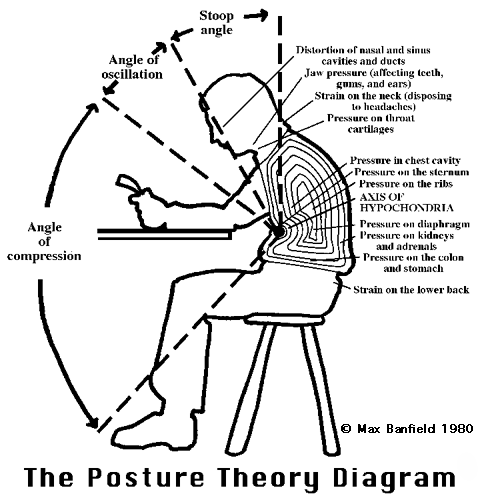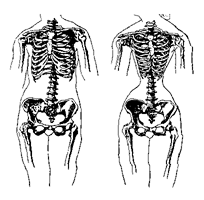The Posture Theory©
A TEST OF SEVEN QUESTIONS FOR STUDENTS
The answers are at the end of the test.
Now 50 questions See here
 |
Scroll in and out of the diagram above to see the effects of repeatedly leaning forward and back.
A concise summary of The Posture Theory
Poor posture pushes the head forward of the bodies centre of gravity and has two major effects.
Firstly it strains the spine and produces a variety of back aches.
Secondly it compresses the chest and abdomen to cause chest pains, breathlessness, fatigue, stomach pains, and other symptoms.
The Posture Theory and fatigue
The fatigue occurs because pressure in the chest cavity impairs the flow of blood between the feet and the brain, disposing to poor concentration and tiredness. The impairment to blood flow can also damage the blood vessels to weaken circulation and result in an impairment in the capacity for physical exertion. M.B.
For a more thorough description of The Posture Theory click here
The Posture Theory Test
Question and Answer Clues
 |
Scroll in and out of the diagram above to see the effects of repeatedly leaning forward and back.
A flat chest confines the chest contents into a smaller space, and leaning forward stabs the tip of the sternum into the stomach.
Repeated leaning may damage the efficiency of the junction between the food pipe and stomach, or may cause a form of ‘repetitive strain injury’ to the stomach muscle etc.
The hunchback poet Alexander Pope had spinal deformities which included a forward stoop in the upper spine, and a severe arch in his lower spine which pushed his abdomen forward. He spoke of his life as “a long disease”, and in one of his poems he wrote about his “headaches, indigestion and a thousand other aches and pains”.
CONTACT THE AUTHOR banfieldm44@gmail.com

Tight waisted corsets of the nineteenth century permanently deformed women’s chests from a barrel shape to a funnel shape. The women suffered from palpitations, breathlessness, severe indigestion, and fatigue, and would faint frequently, especially if they exerted themselves.
They relieved their fainting spells by unlacing their corset and resting in a chaise lounge.
A Introduction to some inconvenient truths
The term hypochondria is applied to any disease that doesn’t show up on x-rays etc, and it is usually deemed that the symptoms must be trivial or imaginary.
That idea sounds believable to doctors and anyone else who doesn’t have such ailments, but most patients don’t believe it and are offended by such casual dismissal of their symptoms. That label is, in fact, more often used as an extremely offensive insult, or a put down, than it is used in either it’s original ancient Greek meaning, or it’s modern completely different definition. It is also deliberately used to shame people out of claiming their entitlements to insurance or compensation, and therefore cannot be passed off as a label of no consequence, as if to say – the patient isn’t really sick therefore he doesn’t deserve consideration, or he is not sick so there is no point in taking the matter seriously.
As the say, if the patient wasn’t mad before the was treated, then it won’t be long before the treatment drives him mad. There is also the concept that if you can drive the patient mad it will make it look as if the madness was the cause of the symptoms in the first place.
I wanted to determine if it was possible to find a better explanation, and everyone knows of people who have back aches that don’t show up on x-rays. One of the interesting things that I found was that the cause of backaches is undetectable in most cases, and that it is officially considered to be unknown. However, at the same time there are statements in the medical literature that there is a condition called postural back pain, caused by faulty posture, and that there is no evidence of broken bones or illness, so obviously it is possible to have real pain when there is absolutely no x-ray evidence of disease. It is not realistic, or believable to routinely assume that everyone who has that type of back pain is a faker, a malingerer, or a mental case.
I also investigated a condition called Da Costa’s syndrome which some authors try to put into the category of hypochondria, or somatoform, and dismiss it as trivial, imaginary, or all in the mind, or caused by anxiety etc.
However, when I studied that condition I found that many of the patients had thin physiques and spinal deformities such as stooped spines, and long, narrow or flat chests. They will say that they are not anxious, but their statements are generally derided and dismissed as being the ‘self-reports’ of patients which are not reliable. Nevertheless, their undetectable chest pains could be caused by postural compression of the chest, and their undetectable breathlessness could be caused by postural compression of the lungs etc, and the chronic problems could be caused by damage which is undetectable.
I then started looking through the medical literature of the past and found that I was not the only one to draw that type of conclusion, so, regardless of what my critics might say, there is absolutely nothing stupid, weird, irrational, or fringy about that idea.
I am saying that it is, in fact, a good explanation for many undetectable, but genuine symptoms and illnesses, and that it not the only one, but is one of many possibilities.
Unfortunately there are some individuals who would like to believe that all such problems have a psychological basis, and don’t want anything else to be considered.
If you want to have a reasonable understanding of The Posture Theory in relation to the cause of one ailment called Da Costa’s syndrome, you can do the following test of seven questions, and then read the answers at the end, to see how you scored. If you have any further interest you are welcome to use the index on the home page to find other topics that interest you. You can then do the larger test of 50 questions here
If you can answer the following 7 questions correctly you will have a good understanding of The Posture Theory as it relates to the undetectable symptoms of Da Costa’s syndrome
Questions
1. What are the 6 main symptoms of Da Costa’s Syndrome
2. What factors produced the idea that the patients had a fear of imaginary illness.
3. What is the difference between the Ancient Greek theory on hypochondria, and the 1980 Posture Theory
4. How does poor posture cause chronic fatigue, and why is the symptom then brought on by vigorous exertion.
5. How does chest shape influence symptoms.
6. Name 6 other factors which contribute to the compression of the upper abdomen and make symptoms more likely to develop.
7. Why is the link between posture and symptoms obscure.
Answers
1. Chest pains, palpitations, breathlessness, faintness and fatigue in relation to exertion, and upper abdominal pain.
2. Because the symptoms exist in the absence of any evidence of disease and are similar to those of heart disease, so it was thought that the patients had a fear of imaginary heart disease.
3. The Ancient Greeks believed that the symptoms of hypochondria had their origin in the upper abdomen (below the rib cartilages), and The Posture Theory shows how they are caused by postural pressure on the upper abdomen.
4. Leaning forward with a stooped spine compresses the air and blood vessels in the chest cavity and slows the blood flow between the feet and the brain to cause faintness and fatigue in the early stages, but ultimately the efficiency of blood flow becomes impaired, so that there is not sufficient flow to maintain the full requirements of physical exertion, especially vigorous exertion.
5. When a person with a normal, large, or barrel shaped chest leans forward the breastbone goes over and around the abdominal cavity, and the contents can be displaced upwards, but when a person with a flat chest leans forward the chest buckles at the midriff and compresses backwards, and that increases the pressure inside the chest and restricts the upward displacement of the abdominal contents.
6. A stooped spine (kyphosis), sideways curvature of the spine, a thin physique, sedentary work involving repetitive leaning toward a desk, tight belts or corsets, and the enlarging womb of pregnancy.
7. Because of subtleties and delays between postural movements and symptoms. For example, for people with stooped spines, slouching takes the strain off the spinal muscles, and feels relaxing, but it transfers the weight of the head and shoulders to the front of the body, but symptoms may not be noticed until several hours later, and chronic problems may take many years to develop. There is also no obvious evidence of disease or injury to account for the symptoms, so it is a matter of asking why people with stooped spines are more likely to have the symptoms, and looking at The Posture Theory Diagram and seeing what effect that physique would have.
Scroll in an out of the Posture Theory Diagram here
To do the full Tests
You have seen some clues in the window above
To do the actual test you can see the fifty questions by clicking here. The answers are at the end of the test.
